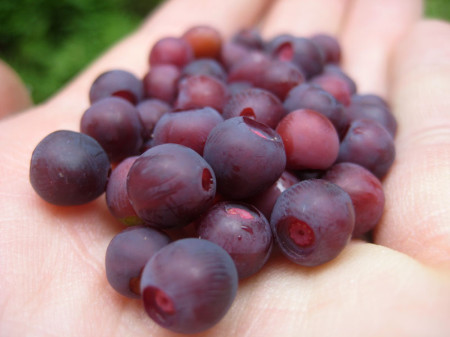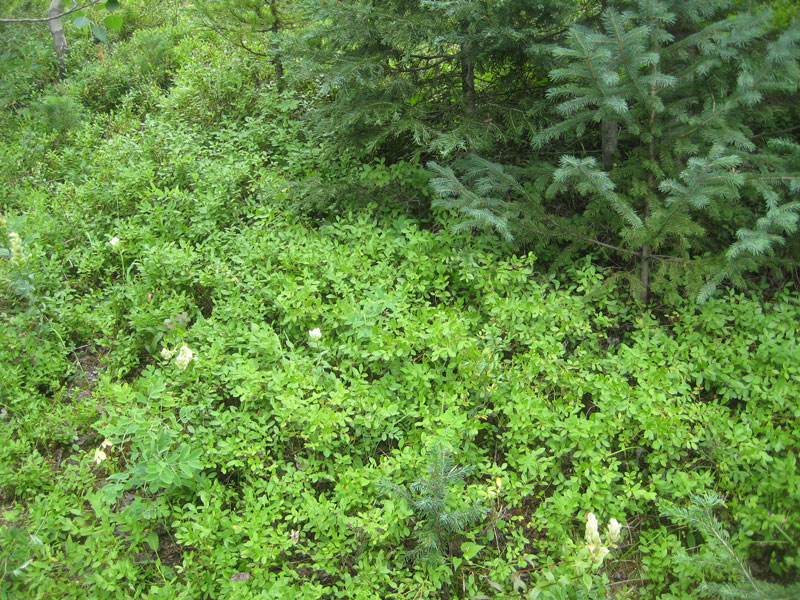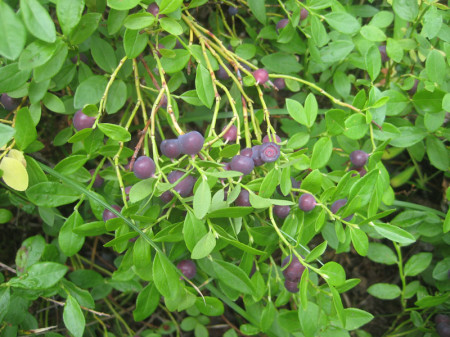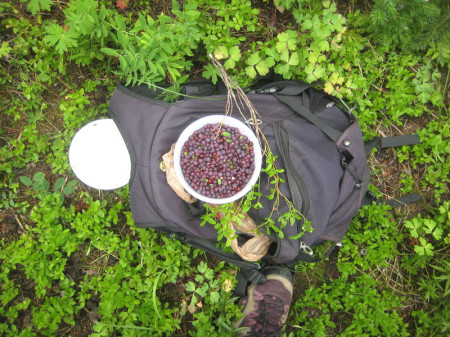
If you’re looking for blueberries like the kind you buy in the grocery store, look elsewhere. The Colorado high country “blueberries” I’m talking about are not those, but several related species of Vaccinium that are smaller, and grow not on a bush but in the groundcover under your feet in the high country. Whereas cultivated blueberries have round depressions surrounded by a crown, our small high country wild blueberries have a round stamp in the berry, but usually not much in the way of a crown. They can be red, maroon, dark blue, powder blue, or purple-blue to almost black, and they range from translucent to opaque.
I generally refer to these high country blueberries as “huckleberries.” There are quite a few names that people use for the wild Vacciniums up here—grouseberries, whortleberries, bilberries, huckleberries, and blueberries among them. But just the other day as I was trying for maybe the hundredth time to distinguish between a couple of our local species, I read in Weber & Wittmann’s Flora of Colorado (2012 ed.) that it is not correct to call them huckleberries, and that “blueberry” is the correct common name. So I thought I’d try that name for this post and see how it felt.

I know of at least three distinct species of Vacciniums up here—the small, red Vaccinium scoparium; the powder-blue-berried, fat oval-leaved, very-low-lying V. caespitosum that grows high up in the hills at and above treeline; and the common V. myrtillus I found yesterday. Confusing matters, they can interbreed.
I’d been scouting a trail that was new to me in the East Vail area in the hopes of spotting mushrooms, but when I found myself in a forest carpeted with low plants bearing small, oval-shaped, pointed leaves, I knew to bend down and glint sideways at them to see if there were any plump, round, gems hanging underneath. Sure enough, I found a ripe berry! Then I found 10 berries. Then I found 100 berries, high up in a beautiful spot at the base of a sun-dappled, conifer-covered hill by the creek, after a good solo hike. I spent a while there gathering half a Cool Whip container full, listening to nature. Good patches can be quite fruitful, but the berries are nonetheless time-consuming, and labor-intensive, to gather. They were so plentiful I hardly made a dent in the berry population there, which I’m sure the bears will appreciate.
I didn’t see any porcini mushrooms on my hike, but I did find a couple fly agaric buttons, which grow into the red-and-white Amanita muscaria “toadstools” of stories. They were still in their cracked yellowy button form, pushing their funny way up through the duff.

It was not until the way back down that I came to the land of 10,000 blueberries, closer to the trailhead and human activity, in a zone of mixed aspen and conifer. I couldn’t believe how many berries draped each small plant, double or triple my good find up high. When they’re like that you can gather them by gently raking the plant with one hand, holding the other underneath to catch them, and then transferring berries a handful at a time into a collecting container. I spent another 30 minutes or so in this patch until my back started hurting from bending over for so long. I managed to get one container full. Not a lot, but enough to share with Gregg and Butter. They really are precious. (The berries, I mean, as well as Gregg and Butter.) And now I know of another a good patch.
Through the Incidental Use Policy, many US Forest Service jurisdictions allow collection of a small amount of wild plants for use in a meal the same day, a policy designed in particular for backpackers hoping to add wild food to their dinners. In our local forests, collecting for commercial use is not allowed without a Special Use Permit. (For mushrooms, a free permit can be obtained at the Dillon Ranger District.)

Gregg was surprised and delighted to see the berries. First, he jumped up off the couch and whipped up some shortbread cookies with them. The cookies were very tasty, although the leftovers were no longer crumbly by morning due to the moisture in the berries, so he will have to tweak the recipe a little. Still, it was a fabulous treat, especially hot out of the oven.
The next night, I cleaned the remaining berries of leaves, hard, white, undeveloped berries, and small woody matter and divided them into two jars. “Here are some cleaned huckleberries,” I told Gregg. “Do you want to do something with them? Or should I sprinkle sugar on them and let them macerate?” He ended up eating half the jar with a fork. I’m not complaining. I’m glad there’s a way to get fruit into this notorious fruit-hater.
I tell you, Colorado’s huckleberries are divine. Oops, I mean blueberries. Or maybe I’ll start calling them bilberries.
Updated 2.22.21

Aw, but huckleberry is really so much more fun to say.
Have you seen the translucent ones? Every time I try sit down with this genus and a flora, I just end up in a big mind bend, and eventually settle with just happily eating them. Maybe in a few more years I’ll get them sorted.
Thank you for the treasure, btw. Holy schmoly, that flavor just never gets old.
I’m voting for bilberries, but huckleberry is the best.
Nice haul! Here in the north east I pick wild blueberries. High and low brush. This year was exceptional. I was able to freeze quite a bit. Looking to forage some wild cranberries in the fall.Thanks for the great post.
I’m so eager to find some of these blueberries, or whatever. First time visitor to your blog and I’ll surely bookmark it.
Is it inappropriate to ask where I could find some of these, preferably off route 24? If you could give me a hint of a trail, I’ll be there tomorrow!
Thanks
They’re by far the best tasting berry in Colorado. I picked a bunch yesterday and plan to make jam with them.
Nice blog btw
Shawn
Thanks for your article and giving a family name and species I can look up!
About fifty years ago, my family had a trailer-based vacation in Colorado. On one hike, my mother swore she smelled blueberries. My dad insisted that he couldn’t smell anything (though her nose was keener than his) and that he didn’t see anything looking anything like the blueberries he picked (during the 1930s on Long Island.) But my mom persisted, finally stooping to look at the low (4″-6″ high) groundcover-ish bushes on both sides of the trail! I think these must have been the Vaccinium scoparium that you mentioned. We picked a couple dixie cups (remember those?) of berries — and debated how best to incorporate them into pancakes the next day. As to naming, my late mother called them blueberries or dwarf blueberries, so I will, too!
–Larry
Boston Area, Mass., USA
I’ve been harvesting chanterelles under these plants for decades and never knew the berries were edible. Well damn, now I can have my trout and chanterelles for dinner and blueberry pancakes for breakfast. Score!
We just moved up by Raymond Colorado and have a small plot of land along the river. We have an amazing, wild raspberry patch already, and we’re hoping to add to it with some native blueberries. Is anybody selling native blueberry plants?
Hi Eric, not that I know of. Our native “blueberries” are quite small but could potentially be transplanted. They typically grow among aspens and spruce/fir. Is that type of plant community on your land? If not there might be better choices for native edibles. Serviceberries are lovely native plants that produce big, blueberry-like berries.
Nice article. I’ve had fun finding wild blueberries in similar areas. another species that I have found not listed in your three is Vaccinium deliciosum. I found this one day on a high mountain pass while elk hunting. A couple of the ones you mentioned I haven’t found yet, so thank you for the names so that i can now look them up and look for them later on.
Ah! That is a species I would like to meet some day if I am in the Pacific Northwest. Safe to assume that’s where you are?
What I found was actually in colorado surprisingly. I knew it was a type of bilberry when I saw it but I didn’t know the specific variety until I ran a few different photos of it through a plant ID app later that day. It surprised the heck out of me because I didn’t think they grew out here. It’s still possible the app mis identified the specific variety, but I did take several different photos and they all ID’d the same so I feel reasonably confident.
According to the range maps, V. deliciosum doesn’t come close to Colorado. It does, however, appear similar to our local V. caespitosum, a low-growing, high elevation Vaccinium with powder-blue berries… maybe that’s what you’ve found?